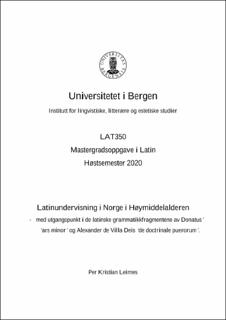Latinundervisning i Norge i Høymiddelalderen - med utgangspunkt i de latinske grammatikkfragmentene av Donatus’ ‘ars minor’ og Alexander de Villa Deis ‘de doctrinale puerorum’.
Master thesis

View/
Date
2020-12-04Metadata
Show full item recordCollections
- Master theses [274]
Abstract
Latin education in Norway can be documented as early as Olav Kyrre when he, in a letter from Pope Gregory, is instructed to send some of his lands’ young nobles to Rome, in order to be enlightened in the ways of the Church and the Scriptures. This indicates that the clergy of the kingdom of Norway is taking part in the ever growing educational programme of the Catholic Church. This thesis has its eyes fixed on elucidating what is, and can be known of the latin instruction in Norway of the High Middle Ages. Mainly, it will look at, and discuss, two fragments; one of the grammarian Donatus’ work Ars Minor, the most ubiquitous grammar in Europe in the Middle Ages, and the other from the grammatical treatise ‘De Doctrinale Puerorum’, written by Alexander de Villa Dei. From these will be discussed the types of educational institutions they may be related to: the parish church, with regards to Donatus being found beneath the floor in relation to an archeological excavation conducted there in the 1970’s, and the cathedral school, due to Alexander’s Doctrinale being attributed to Bryggen in Bergen – this because it was discovered as a cover for a protocol used by the Hansa from Bergen. Monastic schools are also discussed in this thesis, due to their longstandig educational tradition in Europe. The thesis structures itself around these three educational institutions, going through each one in turn, discussing elements related to them. Due to the lack of evidence of the situation concering education in Norway in this time period, we will look to other sources that may be relevant, such as to the school system in England, from whence christianity found its way into Norway, as well as to some of the saga-texts. Because Norway and Iceland were very interconnected at that time, and because Iceland was under the archdiocese of Nidaros, some of it’s sagas – i.e. the Saga of Bishop Laurentius, and also the one of bishop Arne - and other fragmentary sources are used, since they do pertain to the educational situation of both countries. The thesis also uses many excerpts from primary sources to discuss and support its evidence and/or claims. The fragments and other evidence seems to support that Norway – and Iceland, for that matter – are closely following the trends elsewhere in Europe in respect to education. Though there must have been great individual differences, the fragments at Lom, when put into context, supports the idea that education was fairly widespread; Alexander’s doctrinale, and its signs of use, hints at a degree of atleast intermediate levels of grammar being taught within its cathedral schools. The monastic schools’ educational programme here have been more difficult to pin down, and there seems but few sources, and relies thus heavily on foreign sources for its conclusions.